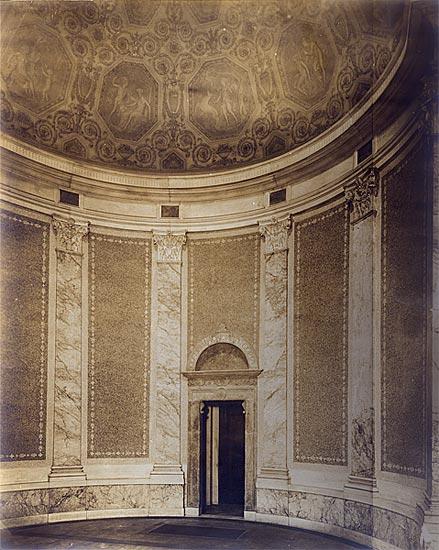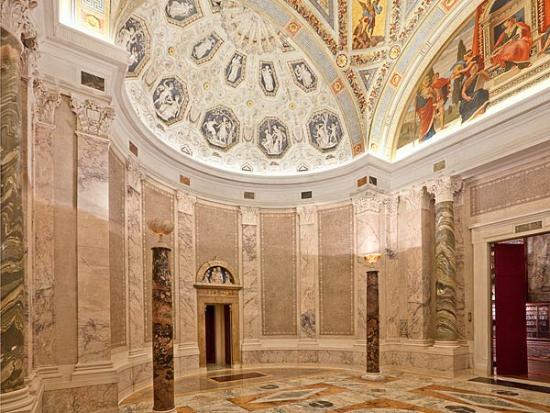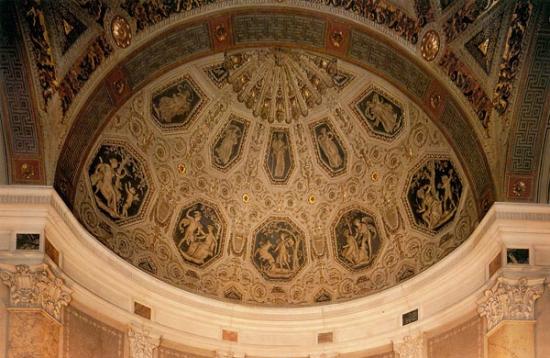The interior of J. Pierpont Morgan’s Library consists of three rooms radiating off the east, north, and west sides of the Rotunda, a vaulted entrance foyer. The largest of the three served as Morgan's library, the room to the west was Morgan's private study, and the smallest of the three, to the north, was an office for Pierpont Morgan's librarian, Belle da Costa Greene (1879–1950).
The restrained simplicity of the façade yields to the splendor of color and texture in the Rotunda, supplied by variegated marble surfaces and columns, mosaic panels, and columns of lapis lazuli. The marble floor, with its central porphyry disc, owes its design to that of the Villa Pia in the Vatican gardens.
The decorative programs for the apse, ceiling, and lunettes of the Rotunda were designed and executed by Harry Siddons Mowbray (1858–1928). Mowbray quoted liberally from Renaissance prototypes, relying principally on the works of Raphael (1483–1520) and Pinturicchio (1454–1513). The decorations of the Rotunda announce the building's role as a repository of the art and ideas of the past, from antiquity to the Renaissance.
The decorations on the blue and white stucco ceiling of the Rotunda's apse are a tribute to Raphael, based on his designs for the Villa Madama in Rome, executed in 1516 for Cardinal Giulio de' Medici (later Pope Clement VII). Against a background of urns and acanthus foliage, the hexagons depict classical figures representing Wheat, Flowers, the goddess Ceres, the Vine, and Fruit. The Larger reliefs represent Venus and Cupid, Mercury and Proserpina, Diana and the Huntress, Cupid and Psyche, and Silenus with the young Bacchus. Mowbray modeled these reliefs in situ, to ensure proper lighting from the oculus.
The paintings of the Rotunda's dome are compositionally inspired by Raphael's famous vault decorations for the Stanza della Segnatura in the Vatican (ca. 1508–11), commissioned by the great humanist pope and patron of the arts, Julius II. Four branches of learning—Religion, Philosophy, Science, and Art—are personified by female figures situated in roundels and surrounded by putti. The four rectangular panels above the spandrels depict The Annunciation, The Crowning of Art (a variation on Raphael's Crowning of Apollo), The Triumph of Light over Darkness (also known as Force Chained by Wisdom), and Knowledge Transmitted (The school of Plato).
The Rotunda Paintings
The three lunette paintings over the Rotunda's main entrance and the doors to the Library and Study are compositionally but not thematically derived from Pinturicchio's decorations for the Borgia apartments in the Vatican (ca. 1492–94). They are a tribute to the great literary epochs of the past and to the authors whose work defined them. Like the ceiling roundels, the lunettes were executed on canvas in the artist's studio and then affixed to the surfaces of the room.
Antiquity (on the east, above the door to Mr. Morgan's Library): Epic Poetry represents the literature of antiquity. At the center, Calliope, the Muse of Epic Poetry, is flanked by Homer and Orpheus, the son of Calliope and Apollo. The figural groupings on either side symbolize the Iliad and the Odyssey: on the left, Thetis arms Archilles in the presence of Athena; on the right, Circe offers the poisoned drink to Odysseus, who is warned by Hermes.
The Middle Ages (on the south, above the original entrance): The Middle Ages are characterized by Arthurian romance and Dante's Divine Comedy. King Arthur and Beatrice, Dante's beloved, flank the central altar upon which burns the sacred flame. At the left are members of King Arthur's court, Tristan and Isolde (in the corner), and Queen Guinevere and Lancelot. Next to Beatrice, Dante and Virgil converse on the right. In the right corner, Paolo reads to Francesca da Rimini of the illicit first kiss of Guinevere and Lancelot, the passage that was to lead to their own adulterous love and consignment to the Inferno.
The Renaissance (on the west, leading to Mr. Morgan's Study): Erato, the Muse of Lyric and Amorous Poetry, is flanked by Torquato Tasso and Francesco Petrarch, their loves and literary creations. The left side of the lunette is devoted to Tasso's Jerusalem Delivered, picturing its protagonist, Godfrey of Bouillon, and his squire, Siger; Tancred and Rinaldo, the crusaders; and Tasso himself with Leonora d'Este. Petrarch and Laura dominate the right side of the lunette with Laura's husband, Hughes de Sade; in the background is Avignon, where Petrarch first beheld Laura.





